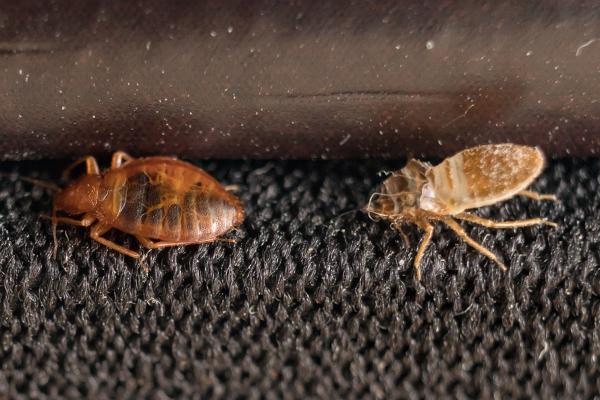Where do bed bugs hide? Bed bugs like to hide in dark, warm, and moist places. They hide at places from where they can get sufficient food – human blood. Thus they hide in the corners of the mattresses, bed linens, carpets, and clothes inside the closet. They also prefer to hide in the human body to get ample food.
Usually, bed bugs feed themselves once in 14 days, and thus they prefer to hide the rest of the time. After feeding human blood, the male bugs retire to dark places, and the female bugs lay eggs if they are fertile.
Why Do Bed Bugs Need to Hide?
The simple answer to this question would be “in order to not get caught” however the reason bed bugs hide is dependent on their behavior.
Bed bugs have a short life span and they require feeding almost once in 14 days. So what do they do the rest of the time? They lie in hiding and procreate. The adult male and female bugs come out once a fortnight to feed. The feeding requires about 3-10 minutes. Once they are full, the bodies of the bugs undergo metamorphic changes so as to accommodate the nutrition. The bugs will then retire to their dark spaces to digest their food and the females will begin laying eggs if the time is right.
Our Curated List For :
What Kind of Spaces Do Bugs Enjoy?
This is a question leading up to the main topic of the article. Where bugs hide, can be judged and identified when you know the kind of places that bugs find attractive.
Bugs are attracted to moist, dark, warm spaces where they can identify a host. Humans form the most convincing hosts for bugs because there is the possibility of ample food along with shelter. Bugs also enjoy an environment of high carbon dioxide concentration. This makes humans their first choice as a host as well.
Where Do Bed Bugs Hide?
The ideal bed bug hiding places:
Listed below are a few spaces that are most popular for harboring bed bugs:
- Seams of cushions, chairs, and even clothes
- In the joints of the drawer
- In tools that have gone rusty and are not being used
- In electrical power points and appliances
- Under wallpaper that has come loose
- In the corners of rooms
- At the joint of the walls with the ceilings
- In bedding and mattresses
- In the springs and foam of the mattress
The list as stated before is exhaustive and can go on for pages, while there would still be areas where you can find them hiding.
Signs of Bed Bug Infestation
It might be days before you see the actual minuscule creatures crawling all over, but the signs of an infestation are there early on. If you are observant enough and can spot one or more of the signs on this list, at your own apartment, it is time for you to call in pest control. The signs to keep an eye out for are as follows:
- Reddish and itching bed bug bite marks on your body are the first and primary indicators of pests.
- These bite marks may or may not be accompanied by blood.
- Look out for bloodstains on your sheets or cushions from previous bed bug feedings.
- Rust-colored or red spots may be found on your sheets when bed bugs are crushed during the night.
- Dark black spots may be found where the infestation is present. This is bed bug excrement that looks like the marks a marker would leave.
- Tiny eggs or eggshells.
- Pale yellow skin is shed when nymphs (baby bugs) grow.
- Actual live bugs you might find lurking around.
What to Do Once You Spot a Bed Bug Colony?
- Firstly, don’t panic. Spotting a colony is half the job done.
- Don’t try any home remedies cause they may be poisonous to humans. This should especially be kept in mind if there are children in the house.
- Call pest control and book an appointment with them at the earliest.
- Check the extent of the infestation. Mark the rooms and areas that have already fallen victim to the bloodsuckers.
- You might want to leave your home for a few days if it is a widespread infection that requires prolonged treatment.
Closing Thoughts
In conclusion, bed bugs are elusive creatures that can hide in a variety of places, including mattress seams, bed frames, and headboards. They can also hide in cracks and crevices in walls and flooring. It’s important to be vigilant and inspect your home regularly for signs of bed bugs to prevent infestations. Remember, early detection and treatment can save you time and money in the long run. Stay safe and sleep tight, without the bed bugs biting!
People also search for –
